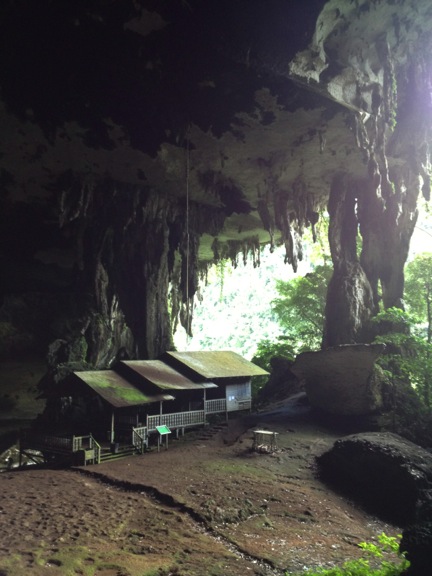By DREW CALVERT

On my final day in Malaysia I visited the Great Cave near the town of Niah, site of the oldest human remains in all of Southeast Asia. To get there, I took a bus from Miri, a city not far from the Brunei border, which brought me close to the main entrance of an unceremonious national park. At the museum, I glanced through photos of Englishmen joylessly separating ceramic from bone, and I studied brochures on the local economy, which runs on bird’s nests and guano. Then I walked through a rainforest thick with cicadas until I reached the mouth of the cave, which looked like a secret airport hangar or a decommissioned gateway to hell. Armed with a flashlight and an outdated map, I followed a mossy path through the darkness and breathed in the prehistoric funk. By sunset, I found myself back at the entrance, where swiftlets and bats converged on each other in a giant black cloud above my head.
For a month I had been tracing Malaysia’s ‘legacy of religious pluralism,’ which is an amateur scholar’s way of excusing his desire to visit holy sites. I began in Malacca, known for its role as ‘the birthplace of modern Malaysia,’ where Buddhist shrines, early mosques, and Portuguese churches coexist. From there I toured the cave temples of Perak’s Kinta Valley, symbols of Qing-era spirituality tucked into elevated jungle terrain. In Penang, I studied the syncretism of the early twentieth century, where Chinese Taoists, Christian missionaries, and Islamic scholars intermingled. In the northern states of Kedah and Kelantan, where kings converted to Islam under the influence of Arab traders, I studied ancient woodcarvings and early drafts of the Malay Koran. Finally, I flew to Sarawak, where more than a third of the population identifies as Christian, thanks to an evangelical mission dating back at least a hundred years. I saw Sanskrit engravings, Javanese deities, medieval mosques, Methodist schools, and rosaries hanging in longhouses next to the masks of Borneo tribes.
***
Malaysia’s diversity is a subject that provokes both fascination and anxiety— there is simply too much conflicting history to keep straight in one’s mind. Islam is still the dominant faith and a major presence in public life, but Malaysia’s Muslim majority has long been exposed to an array of alternative faiths. This pluralism reached a fever pitch in the early twentieth century, as religious leaders of every stripe articulated their vision of the perfect society. Modern Islamic scholars established journals in Singapore and Johor, while Hindu leaders began to spread an anti-imperialist message. In 1900, the Confucian reformer Kang Youwei conducted a tour of Southeast Asia and made the case for a Chinese religion that could compete with Western Christianity. His adherents set up reading groups, conferences, terraced temples, and several branches of something called the Celestial Reasoning Association. All of this history is reflected in the life of Malaysian cities today. One night in Johor Baru, I saw Muslim men in long white robes buying yellow wreathes from a Hindu temple. At a bus station near the border with Thailand, a Chinese Christian lectured me on Arabic root words in Malay.
***
The question for historians of Southeast Asia is: how far should one go back? The region was only acknowledged as such once it became a battleground during World War II (an hour before Pearl Harbor was bombed, Japanese soldiers were cycling through the jungles of Kelantan); what used to be known as ‘the Malay Archipelago’ is now a bloc of postcolonial nations. Indonesia and Malaysia were separated by the Anglo-Dutch Treaty of 1824. The Philippines, a former Spanish colony, found itself under U.S. control by the turn of the twentieth century. (All three were officially independent within a decade or so of the Japanese surrender.) Sarawak, Malaysia’s largest state on the northern coast of Borneo, was ruled by a single family, the Brookes, from 1841-1941, a state of affairs that inspired parts of Joseph Conrad’s novel Lord Jim.
Such history is responsible for more than national borders and institutions: it influenced how millions of people interpreted the nature of their existence, including the language and symbols they use to communicate with a higher power. The divisive rhetoric of religious leaders (for instance, the debate over whether Christians should use the term ‘Allah’ in Malay-language scripture) usually refers to classifications that are political by nature. The sermons and regular public speeches (known locally as ceramah) grow boring after a while; reading the plaques outside the mosques is usually much more edifying. It’s also revealing to consider the diaries of early twentieth century intellectuals, who struggled to define their personal faith at a time of profound uncertainty. Some prayed to Confucius as if he were Mohammed. Others worshiped Jesus Christ as if he were an ancestor. A handful of Malay nationalists were enthralled by Japanese theories of spiritual power.
***
My instinct, when faced with human conflict, is to investigate features of our shared past, most of which is marked by lengthy periods of widespread religious belief. It may be a naïve and aimless project, this casting around for commonalities. After all, the traumatic undertow of Asian politics cannot be addressed by religious studies. Historical wounds are far from healed, and the borders are still not firmly settled. Skirmishes over territory in the South China Sea, from clusters of islands to the coast of Sabah, certainly have the potential to spark a regional catastrophe. Plus, the world has become ‘disenchanted’; we don’t need to bother about superstitions masquerading as spiritual impulses. But sometimes I think we could all benefit from some time in a prehistoric cave, where ‘heritage’ sounds like a meaningless word, where ‘tradition’ is not much better, and where all one sees are crude depictions of human aspiration.
Drew Calvert’s work has appeared in The Literary Review, The American Reader, The Los Angeles Review of Books, and elsewhere.
Photo by the author




